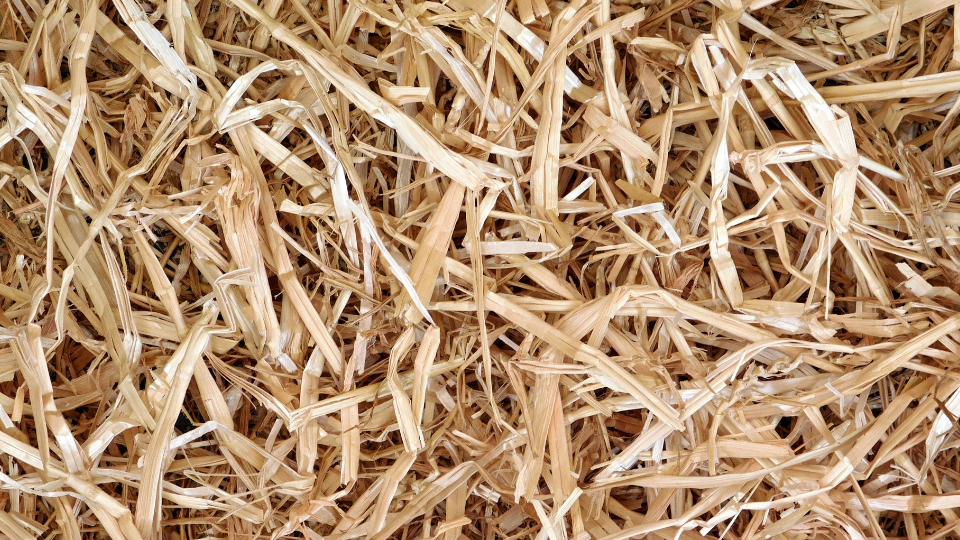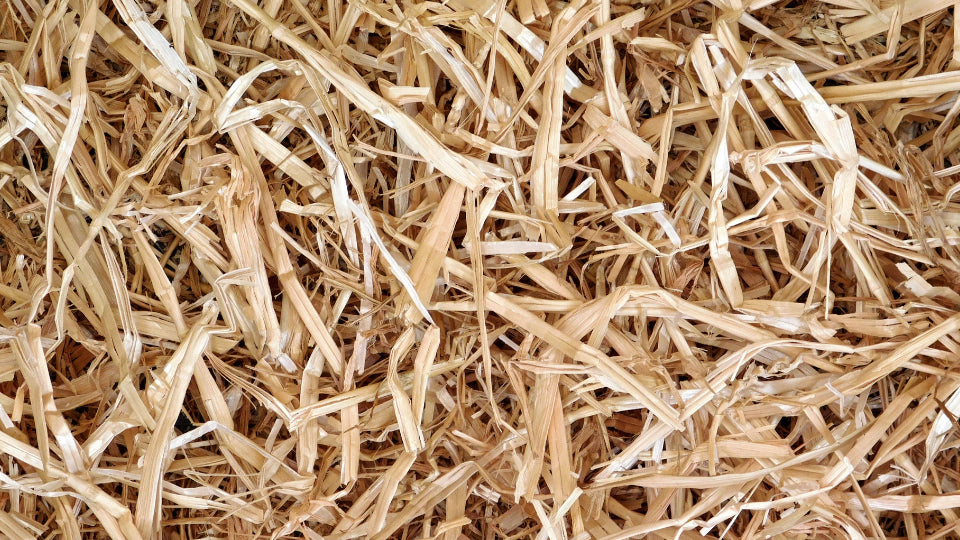Common Mushroom Substrates
Pasteurized Straw is commonly used to grow oyster mushrooms. It is cheap and effective, albeit a little messy.
Hardwoods such as oak, beech and maple make for a great substrate for many types of mushrooms, especially when combined with a bran supplement.
Soy hulls can be mixed with hardwood sawdust at different ratios to produce extremely effective and high yielding substrates, particularly for growing oysters.
Common button mushrooms are grown on composted manure, specially prepared using a two phase composting and sterilization process.
Coir is a commercially available mix of ground up coconut husk and shells which can be mixed with vermiculite to create an effective substrate.
Mushrooms will grow on a number of urban and agricultural waste products, from spent coffee grounds to banana leaves.
What is a Mushroom Substrate?
To put it simply, a substrate is a bulk material that the mushroom mycelium can use for energy and nutrition. A good substrate is required in order for the mushroom to grow and to fruit. Common substrate recipes for growing mushrooms usually involve straw or hardwood sawdust, although there are many other good options to be considered. The mushroom substrate needs to be properly prepared by adding water, potentially adding additional nutrition, and further processed by sterilization or pasteurization. When ready, it can be “Innoculated”, wherein broken up pieces of mycelium-covered grain, also known as grain spawn, are evenly mixed into the substrate. Under the right conditions, the mycelium will start to grow, rapidly devouring and decomposing the organic material in a process known as “colonization.” The mushrooms are ready to fruit once the substrate is fully colonized- meaning it has been completely consolidated and encompassed by the mycelium.
Pasteurizing or Sterilizing the Substrate
Ideal mushroom substrates are moist and full of nutrition. Unfortunately, there are many other things that also thrive in these conditions, such as molds and bacteria. These contaminants can grow much faster than the mushroom mycelium, so something needs to be done in order to give the mushroom an advantage in the race to colonize the substrate. This can be accomplished by the process of sterilization or pasteurization. Pasteurization is the process of heating up a substrate between 150-180 deg F for a period of 1.5-2 hours. It doesn’t remove all the contaminants, but it will reduce the overall population of other microbes to a level that gives the mushroom species a head start. Some microorganisms will survive pasteurization and remain in the substrate in some capacity, but can actually helpful for the growth of the mushroom in the long run. A burner set up for pasteurizing straw.
A burner set up for pasteurizing straw.
 Straw cooling after being pasteurized.
Straw cooling after being pasteurized.

Water in the Substrate
Mushroom fruiting bodies are 70-90% water, and all of that water is drawn up from the substrate. Unlike plants, mushrooms are not “watered” during the growing cycle. Of course, humidity needs to be added to the air so that the substrate doesn’t dry out, but all of the water that mushrooms require to grow is added to the substrate before inoculation. For this reason, the substrate needs to be properly hydrated during preparation. For straw, this typically occurs during the pasteurization process, when the straw is soaked in hot water. For supplemented sawdust fruiting blocks, an appropriate amount of water should be mixed into the sawdust before the sterilization process. If your substrate is too dry, growth will be slow, and the mushrooms may fail to overtake the substrate at all. On the other hand, if the substrate is too wet, it may encourage bacterial growth and inhibit full colonization. Getting just the right amount of water in your substrates definitely takes some practice.
Different Substrates for Different Mushrooms
Different species of mushrooms have different preferences of substrates, although there is definitely some flexibility in what you can use successfully. Most varieties of oyster mushrooms grow well on straw. This includes Blue Oysters, Pearl Oysters, Yellow Oysters and Pink Oysters. Even King Oysters will grow well on straw, although you can expect a higher yield, and better looking mushrooms if you grow Kings on sawdust instead. Most other gourmet and medicinal mushrooms grow best on supplemented hardwood sawdust. This includes Reishi, Lions Mane, Maitake and Shiitake. Oysters will also grow well on hardwood sawdust. A standardized fruiting block recipe will work well for all the species listed here, but it is definitely worth playing around with moisture content and supplementation level to see if slight variations make a difference.- Blue Oysters
- Yellow Oysters
- Pink Oysters
- Pearl Oysters
- Reishi
- Lions Mane
- Shiitake
- King Oysters
Using Straw as a Substrate
Straw is a cheap and extremely effective substrate that works well for many types of mushroom species. Straw is the stem portion of grains such as wheat, barley or oats – it’s basically what is left over after the grain itself has been removed. In many ways, straw is an agricultural waste product. If you live near a farming community, you should have no problem finding straw. A 40lb (dry weight) square bail should cost no more than $2-4. Keep in mind that straw is messy to work with – it needs to be chopped, cleaned and pasteurized before being used as a substrate. It works best for medium to large grow operations which have a separate prep area and a large drum for pasteurization.
Using Hardwood Sawdust and Chips
Hardwood sawdust makes for an excellent mushroom substrate, and is commonly used in industry. It is a waste product of the lumber industry, and might be cheap and easy to find, depending on your location. The fine sawdust is typically mixed with wood chips, which seems to allow for faster colonization of the substrate and provide a better structure for the mycelium to take hold.

- 5 cups of hardwood pellets
- 1.4 liters water
- 1-1/4 cups wheat bran
Supplementation
Mushroom substrates can supercharged by adding an easily consumed and highly nutritious supplement that the mushroom mycelium can use to grow faster and stronger. Supplementation will also produce larger yields! Be careful though, as too much supplementation can cause higher rates of contamination. Typically, supplementation is achieved by adding bran (oat bran or wheat bran) at a ratio of 5-10% dry weight. Substrates that are supplemented absolutely need to be fully sterilized or else contaminants will quickly take over. Even after full sterilization, the chance of contamination goes up linearly with the amount of supplementation- and eventually you reach a point of diminishing returns. Interestingly, Shiitake mushrooms require lower levels of supplementation in order to produce the best results. Over-supplemented shiitake mushrooms can produce strange and unsellable mutated looking fruiting bodies.
The Masters Mix
If you’re looking for an extremely effective substrate for growing oysters, you might want to try what’s know as the Master’s Mix – a 50/50 mix of sawdust and soyhulls, sterilized at 15 PSI for 2.5 hours. The original “master” behind this mix is T.R. Davis from Earth Angel Mushrooms. You will not likely find any another substrate that will yield as much on the first flush as this mix. There are two downsides to using soy hulls as far as I can tell. Firstly, the second flush will not be anywhere nearly as strong as the first flush, even though the huge first flush definitely makes up for it. Secondly, the mix doesn’t seem to colonize as fast as the more traditional supplemented sawdust formula. It’s possible that this is only in my experience, so your miles may vary.Growing Mushrooms on Manure
Most people think that mushrooms grow on manure- which is indeed true. Although most gourmet species prefer hardwood sawdust or straw, there are many common species that grow best on manure. Agaricus species, such as the common button mushroom and the portobella mushroom, as well as many Psilocybin species, are good examples.
Growing Mushrooms on Coco-Coir
Another common material used to grow mushrooms at home is coco-coir. Coco-coir is a natural material made from the husk and the shell of coconuts. It is commonly used for quasi-hydroponic plant growing systems. It does a good job of retaining water, and although it doesn’t provide many nutrients for plants, it is reasonably nutritious enough for growing mushrooms, although not so much so that contaminates easily proliferate. Coco coir is often mixed in a 1:1 ratio with vermiculite to form a suitable mushroom substrate. Vermiculite is an expanded mineral that provides structure to the substrate and retains water, though it is nutritionally inert. The coco-coir vermiculite mix still needs to be properly pasteurized before being inoculated with mushroom grain spawn.Growing Mushrooms on Coffee
Although it is possible to use nothing but spent coffee grounds as a mushroom growing substrate, it is usually not the best choice. Coffee grounds are high in nitrogen, which provides plenty of energy for the mycelium and helps produce higher yields. This richness of the straight coffee substrates however, make for higher chances of contamination. Coffee grounds are better used as a supplement added to other substrate materials, such as hardwood sawdust or coco-coir. Coffee grounds should be fully sterilized before being added to the substrate, but you can often get away with just pasteurization.Uses for Spent Mushroom Substrate
If you start to grow a lot of mushrooms, you might soon end up with large piles of spent substrate that you don’t know what to do with. The shear volume of substrate can add up really quick- so it’s good to have some idea of what to do with it all. The most obvious choice, if you have a reasonably small amount of spent substrate, is to compost it. Just leave your substrate in a pile outside and let the natural process of decomposition take hold. Chances are good that you might even get an extra flush or two of mushrooms in your compost pile! It doesn’t take long before your spent substrate will decompose into a rich loamy compost that can be added to your vegetable garden.




